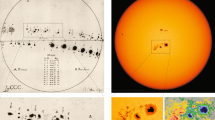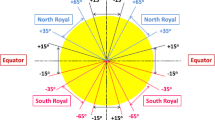Abstract
The spectra of the PROBA2/LYRA data, similarly to every other solar time series, show predominant periodicities that can be of solar or instrumental origin. In this article, we compare the main periodicities characterizing the LYRA spectrum to those found in the sunspot number, in the 10.7 cm flux, in an X-ray flare index, and in the sunspot area evolution. We focused on the 2010 to 2014 time range, for which the LYRA data are available, although we also briefly address the evolution of the main periodicities in the longer range. The mid-term periodicities at \({\sim}\,28\), \({\sim}\,44\), \({\sim}\,54\), \({\sim}\,59\), \({\sim}\,100\), \({\sim}\,110\), and \({\sim}\,150\) days appear as highly significant in several analyzed datasets. The consistency of distinct periodicities between datasets provides characteristics for the global Sun. This consistency also strengthens the reliability of LYRA data.




Similar content being viewed by others
References
Abreu, J.A., Beer, J., Steinhilber, F., Tobias, S.M., Weiss, N.O.: 2008, For how long will the current grand maximum of solar activity persist? Geophys. Res. Lett. 35, L20109. DOI .
Bai, T., Sturrock, P.A.: 1993, Evidence for a fundamental period of the Sun and its relation to the 154 day complex of periodicities. Astrophys. J. 409, 476. DOI .
Chowdhury, P., Choudhary, D.P., Gosain, S., Moon, Y.-J.: 2015, Short-term periodicities in interplanetary, geomagnetic and solar phenomena during solar cycle 24. Astrophys. Space Sci. 356, 7. DOI .
Dominique, M., Hochedez, J.-F., Schmutz, W., Dammasch, I.E., Shapiro, A.I., Kretzschmar, M., Zhukov, A.N., Gillotay, D., Stockman, Y., BenMoussa, A.: 2013, The LYRA instrument onboard PROBA2: description and in-flight performance. Solar Phys. 286, 21. DOI .
Eddy, J.A.: 1977, Climate and the changing sun. Clim. Change 1(2), 173. DOI .
Getko, R.: 2014, The Ten-Rotation Quasi-periodicity in Sunspot Areas. Solar Phys. 289, 2269. DOI .
Horne, J.H., Baliunas, S.L.: 1986, A prescription for period analysis of unevenly sampled time series. Astrophys. J. 302, 757. DOI .
Joshi, B., Joshi, A.: 2005, Intermediate-term periodicities in soft X-ray flare index during solar cycles 21, 22 and 23. Solar Phys. 226, 153. DOI .
Joshi, B., Pant, P., Manoharan, P.K.: 2006, Periodicities in sunspot activity during solar cycle 23. Astron. Astrophys. 452, 647. DOI .
Krivova, N.A., Solanki, S.K.: 2002, The 1.3-year and 156-day periodicities in sunspot data: wavelet analysis suggests a common origin. Astron. Astrophys. 394, 701. DOI .
Lean, J.L., Brueckner, G.E.: 1989, Intermediate-term solar periodicities – 100 – 500 days. Astrophys. J. 337, 568. DOI .
Lomb, N.R.: 1976, Least-squares frequency analysis of unequally spaced data. Astrophys. Space Sci. 39, 447. DOI .
Press, W.H., Teukolsky, S.A., Vetterling, W.T., Flannery, B.P.: 2007, Numerical Recipes. The Art of Scientific Computing, 3rd edn. Cambridge University Press, Cambridge.
Rieger, E., Kanbach, G., Reppin, C., Share, G.H., Forrest, D.J., Chupp, E.L.: 1984, A 154-day periodicity in the occurrence of hard solar flares. Nature 312, 623. DOI .
Scargle, J.D.: 1982, Studies in astronomical time series analysis. II – Statistical aspects of spectral analysis of unevenly spaced data. Astrophys. J. 263, 835. DOI .
Stuiver, M., Braziunas, T.F.: 1989, Atmospheric C-14 and century-scale solar oscillations. Nature 338, 405. DOI .
Sturrock, P.A., Bai, T.: 1992, Search for evidence of a clock related to the solar 154 day complex of periodicities. Astrophys. J., 337. DOI .
Sturrock, P.A., Scargle, J.D., Walther, G., Wheatland, M.S.: 1999, Rotational signature and possible R-mode signature in the GALLEX Solar neutrino data. Astrophys. J. Lett. 523, L177. DOI .
Tan, B., Cheng, Z.: 2013, The mid-term and long-term solar quasi-periodic cycles and the possible relationship with planetary motions. Astrophys. Space Sci. 343, 511. DOI .
Torrence, C., Compo, G.P.: 1998, A practical guide to wavelet analysis. Bull. Am. Meteorol. Soc., 61. DOI .
Usoskin, I.G., Solanki, S.K., Kovaltsov, G.A.: 2007, Grand minima and maxima of solar activity: new observational constraints. Astron. Astrophys. 471, 301. DOI .
Vaughan, S.: 2005, A simple test for periodic signals in red noise. Astron. Astrophys. 431, 391. DOI .
Wolff, C.L.: 1983, The rotational spectrum of g-modes in the Sun. Astrophys. J. 264, 667. DOI .
Acknowledgement
LYRA is a project of the Centre Spatial de Liege, the Physikalisch-Meteorologisches Observatorium Davos and the Royal Observatory of Belgium funded by the Belgian Federal Science Policy Office (BELSPO) and by the Swiss Bundesamt fur Bildung und Wissenschaft. We acknowledge WDC-SILSO for the Daily Sunspot Number data, the Royal Observatory of Belgium, Brussels and NGDC for other solar data. The wavelet software provided by C. Torence and G. Campo is also acknowledged. We wish to express our gratitude to D. Berghmans for internally reviewing our paper. We also wish to express our gratitude to S. Willems for her help in the plot design. The authors acknowledge the support from the Belgian Federal Science Policy Office through the ESA-PRODEX programme, the Solar-Terrestrial Center of Excellence, as well as the Belgian Network CHARM (Contemporary physical challenges in Heliospheric and AstRophysical Models, IAP P07/08).
Author information
Authors and Affiliations
Corresponding author
Ethics declarations
Disclosure of Potential Conflicts of Interest
The authors declare that they have no conflicts of interest.
Appendix
Appendix
Rights and permissions
About this article
Cite this article
Wauters, L., Dominique, M. & Dammasch, I.E. LYRA Mid-Term Periodicities. Sol Phys 291, 2135–2144 (2016). https://doi.org/10.1007/s11207-016-0960-8
Received:
Accepted:
Published:
Issue Date:
DOI: https://doi.org/10.1007/s11207-016-0960-8






